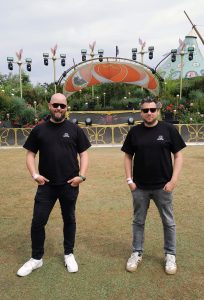KLSTR was founded in 2019 with a clear mission: to make networking technology accessible by simplifying the management of lighting fixtures. To fully grasp this innovative workflow, which aims to challenge the current way lighting professional’s setup and manage lighting rigs, TPi visited one of the world’s largest and most technologically advanced festival sites – conveniently located near KLSTR’s innovation headquarters.
“Our vision is to give the users a modern way of configuring and managing their lighting rig. We want users to simply connect their fixtures and have their setup ready to go with just a few button clicks. We identified that being able to read out the cable topology of the fixtures is the key to a faster workflow,” explained Roel Apers, co-founder and CEO of KLSTR, speaking to TPi on site at Tomorrowland’s Love Tomorrow conference.
“Our new workflow is designed to discover the fixtures in the right connection order, by simply assigning a fixture ID and autopatch, or uploading an MVR file to the rig, and your setup is fully configured.”
Drawing on their expertise in sophisticated network switches and insights into improving lighting professionals’ workflows with modern IT protocols, Apers and the team behind KLSTR developed a system to accelerate bringing the lighting rig online and troubleshoot it in a fraction of the time that’s needed with current technology. The result: KLSTR.nano, which is based on DMX/RDM, and KLSTR.one, which is based on Gigabit ethernet.
Both solutions are based on a hardware chip implemented in the fixture that communicates with their free KLSTR.ctrl application. This plug and play ecosystem equips lighting professionals with the tools needed to manage the complexities of modern lighting rigs.
“Productions using the KLSTR ecosystem save significant time benefits, enhance operational reliability, and unlock a wide array of operational, creative and logistical benefits. We believe it’s time to innovate within an industry that brings emotion to millions of people,” Apers continued.
“With KLSTR.nano, we can read the cable topology of your DMX line, with this information our application draws a visual representation of your system. Making it super easy to configure everything. Apart from that, it’s a radically different approach from a traditional DMX bus,” he added.

“We create point to point connections, allowing you to daisy chain up to 100 devices with 600 metres of cable between two devices. In case of failure, KLSTR.nano can even show you a shorted cable between two fixtures while keeping all devices online as well as many more cool tricks.”
KLSTR.one is based on the same idea where cable topology is key, but this is ethernet-based. With existing ethernet systems, multiple settings must be correctly configured, being time consuming, with a lot of room for error.
“KLSTR.one is based on the idea that if we integrate a managed ethernet switch inside the device and use modern day IT techniques, the application can use the information inside the network switch to unlock a super-fast workflow,” Apers explained.
Simply connect your devices, open the application and the application will instantly discover the devices via IPv6. The application will then collect all information from the device and draw how they are connected to each other. “Once a fixture ID is assigned, you’re good to go. One of the other advantages is that you are allowed to make rings for redundancy,” Apers noted.
“We have a deep connection with Tomorrowland; being a Belgium-based company, it’s rewarding to contribute to the world’s largest festival right on our doorstep,” Apers expressed enthusiastically. “Each year brings new developments across the site, prompting us to provide unique solutions that empower lighting professionals’ creativity.”
To this end, KLSTR featured on the lighting rig for CORE stage, featuring Lucenti PixlStripOne devices connected several PixlDrive 8s with KLSTR.one embedded. Lust For Life, a technical production company for several stages of the festival, adopted KLSTR.nano for the Rise stage. Ayrton Cobras were also equipped with KLSTR.nano on the Main Stage. “The feedback from end users has been overwhelmingly positive,” Apers proudly reported.
Beyond Tomorrowland’s glamour, Luke Edwards emphasised KLSTR’s utility on smaller tours, or one day events saving time when working with local crews unfamiliar with fixture types.
“By just saying ‘those fixtures go in a line over there‘ without needing to know fixture numbers is huge when it comes to saving time during load-in. With KLSTR, being able to put them in the right address just by reloading your MVR is so easy,” he noted.
Following a successful debut at Prolight + Sound, KLSTR showcased the creative capabilities or the platform for the first time in the UK at London’s PLASA Show. “Although we currently have been testing our system on the Belgian market, we’re of course talking with several big manufacturers and rental houses, so expect to see more KLSTR devices on the market soon,” Apers concluded.
Words: Jacob Waite
Photos: Tomorrowland and TPi






